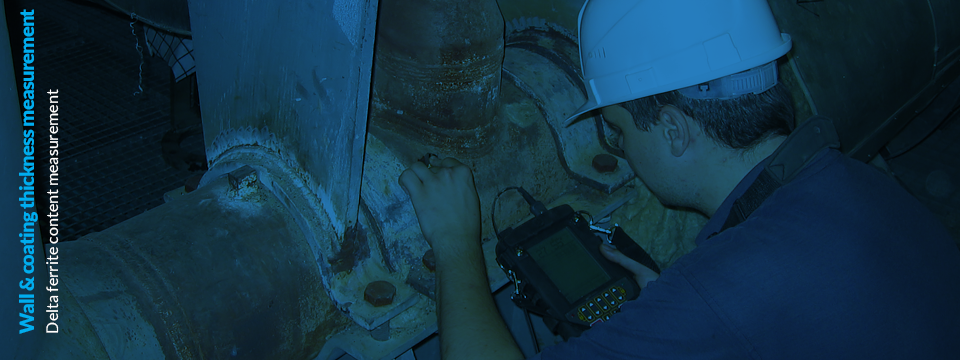- Home
- IWT
- Industrial inspection
- NDT
- Non-destructive material testing
- Radiographic testing (RT)
- Ultrasonic testing (UT)
- Wall thickness measurement
- Delta ferrite content measurement
- Magnetic particle testing (MT)
- Dye penetrant testing (PT)
- Visual testing (VT)
- Leak testing (LT)
- X-ray fluorescence analysis (PMI)
- Mobile spectral analysis (PMI)
- Mobile hardness testing (HT)
- Destructive material testing
- Non-destructive material testing
- Industry experience
- Contact

Ultrasonic testing (UT)
Wall thickness measurement
Delta ferrite content
measurement
Magnetic particle testing (MT)
Dye penetrant testing (PT)
Visual testing (VT)
Leak testing (LT)
X-ray fluorescence analysis (PMI)
Mobile spectral analysis (PMI)
Mobile hardness testing (HT)
Wall and coating thickness measurement
With our state-of-the-art testing equipment, we can carry out reliable measurement of wall and coating thickness.
Wall thickness measurement
Here, we use various digital ultrasonic instruments that allow us to measure the wall thickness of coated components and to determine the residual wall thickness of pipelines, pressure vessels, boiler pipes in power plants, storage tanks and many other components that are exposed to corrosion or erosion. Both metals and various non-metals can be tested, for example glass, ceramics, plastics etc.
Expertise in small power plants!
Especially in the field of biomass cogeneration plants, we have a high degree of experience and detailed knowledge of boiler systems, and also can deliver measurement solutions for hard-to-reach areas, providing you with advice and assistance for the complete revision of your plant.
Non-destructive coating thickness measurement,
using the magnetic induction and/or eddy current method. With our mobile measuring equipment we can carry out testing almost anywhere. Here, the areas of application are:
Coating thickness measurement of non-magnetic coatings such as Zn, Cr, Cu, tin on steel paints, varnish, plastic on steel or on Al, Cu, brass enamel coatings in steel tanks, thick insulation coatings on iron, thick conductive coatings on iron, and nickel coatings on non-ferrous materials. We can also measure cladding coatings for you, for example on boiler pipes in power plants.
Delta ferrite content measurement
Chemical, energy and processing plants are often exposed to heat, aggressive media and high pressure. These situations require the use of steels that are highly corrosion- and acid-resistant and can resist mechanical stress even at high temperatures. If the material contains too little ferrite, the weld is susceptible to hot cracking, and if too much is present, the robustness and ductility as well as the corrosion resistance of the steel will be reduced. With duplex steels, a lack of ferrite in the weld area results in a reduction in stress corrosion cracking and strength.
We measure the ferrite content in austenitic and duplex steels using the magnetic induction technique. Areas of application are on-site measurements, for example austenitic claddings and welds in stainless steel tubes, tanks, boilers and other products made of austenitic or duplex steel.


